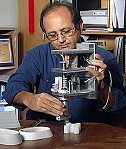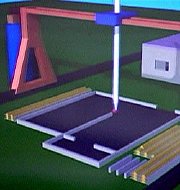WHOLE HOUSE MACHINES
Whole House MachinesHome construction may go futuristic. One researcher says his invention may produce houses at a fifth of their current cost, built completely by machine, in only one day. Brave New Abodes Building enthusiasts often speak of home improvement experts like Bob Vila with a reverence that one California scientist doesn’t seem to share. That’s because he’s reserving the sentiment for a house-building robot that could make by-hand construction and the people who champion it historic footnotes. “What we’re shooting for is technology that can build houses that are equipped with plumbing, electric, communications networks, even painted with wallpaper design … all in less than 24 hours for an average size home,” explains Behrokh Khoshnevis, a University of Southern California engineering professor who invented a device designed to build an entire house with hardly any manual labor. “The only things that will not be done are the doors and windows.”
Khoshnevis calls the system Contour Crafting (CC) and told Discover Magazine that the idea came to him in 1994, after an earthquake cracked a wall in his Los Angeles home. “I had decided to fill the crack myself so I bought some plaster,” he says, explaining that the more he examined the trowel he was using, the more he thought the tool ripe for automation. “I decided to combine … the method of automatically delivering material by extrusion and smoothening,” he says, adding that he’s refined his design to solve engineering issues. “It will be capable of building functionally gradient structures, meaning it can build more strength in areas where strength is needed … It can even change the chemistry and the composition of the material that is delivered in different sections.”
The robot’s promise — a portable “worker,” safer construction conditions, speedier building, reduced costs — make it perfect for many uses. Chief amongst these is disaster relief. Consider the 2004 Indian Ocean earthquake and subsequent tsunami. UNICEF estimates that over one million people were left homeless after the catastrophe. Many of them are still without housing. “It takes several months to years before the victims of a disaster incident are placed in permanent houses,” says Khoshnevis. “And that’s because the construction process that we do today is very slow. With Contour Crafting is the potential to quickly respond … by very rapidly building dignified houses, not tents.” And there seems to be no limit to what — and where — CC can build. Recently, Khoshnevis sold a machine to NASA. The agency’s interested in using it to build on other planets. “It is possible to extract, for example, lunar soil called regolith and melt it using solar power and extrude the melt much like volcanic flowing lava to construct the structures with flowing lunar material” on the Moon, Khoshnevis says. For us Earth dwellers, the idea of living in a world of concrete homes makes some aesthetes go squeamish. Not to worry. The robot can work any fluid material, including a mix of epoxy and wood chips, to build more traditional-looking structures. Plus, it’s capable of sculpting curved walls. So, you can design a home that looks more like Spain’s Museo Guggenheim Bilbao than the ranch down the road. Now that’s thinking about home construction outside the box. Khoshnevis’ work was presented at the 2002 International Symposium on Automation and Robotics in Construction, and was funded by the National Science Foundation and the Office of Naval Research. |

